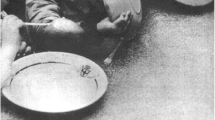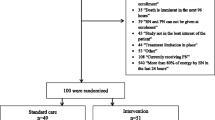Abstract
Malnutrition is a persistent problem in hospitals and intensive care units (ICUs) worldwide. Critically ill patients quickly develop malnutrition or aggravate a preexisting malnutrition because of the inflammatory response, metabolic stress and bed rest, which all cause catabolism [1, 2]. The persistence of this problem despite existing guidelines, is partly explained by the absence of immediately visible consequences of acute malnutrition: Deleterious consequences are not easily measurable and become obvious only after 7 – 14 days, i.e., frequently after discharge from the ICU. Nevertheless, after a week already, new infections may be attributable to incipient malnutrition [3, 4]. In contrast, the biological consequences of insufficient oxygen delivery are immediate, requiring the ICU team’s rapid attention. This longer time constant between event and consequence is one of the important reasons why nutritional therapy is so frequently forgotten early on, resulting in progression of energy deficits, in turn associated with impaired outcome.
Access this chapter
Tax calculation will be finalised at checkout
Purchases are for personal use only
Preview
Unable to display preview. Download preview PDF.
Similar content being viewed by others
References
Thibault R, Chikhi M, Clerc A, et al (2011) Assessment of food intake in hospitalised patients: A 10-year comparative study of a prospective hospital survey. Clin Nutr 30: 289–296
Alberda C, Gramlich L, Jones N, et al (2009) The relationship between nutritional intake and clinical outcomes in critically ill patients: results of an international multicenter observational study. Intensive Care Med 35: 1728–1737
Rubinson L, Diette GB, Song X, Brower RG, Krishnan JA (2004) Low caloric intake is associated with nosocomial bloodstream infections in patients in the medical intensive care unit. Crit Care Med 32: 350–357
Braga M, Gianotti L, Constantini E, et al (1994) Impact of enteral nutrition on intestinal bacterial translocation and mortality in burned mice. Clin Nutr 13: 256–261
Möwe M, Bosaeus I, Rasmussen HH et al (2008) Insufficient nutritional knowledge among health care workers? Clin Nutr 27: 196–202
Dissanaike S, Shelton M, Warner K, O’Keefe GE (2007) The risk for bloodstream infections is associated with increased parenteral caloric intake in patients receiving parenteral nutrition. Crit Care 11: R114
Krishnan JA, Parce PB, Martinez S, Diette GB, Brower RG (2003) Caloric intake in medical ICU patients: Consistency of care with guidelines and relationship to clinical outcomes. Chest 124: 297–305
McCowen KC, Friel C, Sternberg J, et al (2000) Hypocaloric total parenteral nutrition: effectiveness in prevention of hyperglycemia and infectious complications—a randomized clinical trial. Crit Care Med 28: 3606–3611
Berger MM, Mechanick JI (2010) Continuing controversy in the intensive care unit: why tight glycemic control, nutrition support, and nutritional pharmacology are each necessary therapeutic considerations. Curr Opin Clin Nutr Metab Care 13: 167–169
Dvir D, Cohen J, Singer P (2005) Computerized energy balance and complications in critically ill patients: An observational study. Clin Nutr 25: 37–44
Villet S, Chioléro RL, Bollmann MD, et al (2005) Negative impact of hypocaloric feeding and energy balance on clinical outcome in ICU patients. Clin Nutr 24: 502–509
Weir JB (1949) New methods for calculating metabolic rate with special reference to protein metabolism. J Physiol 109: 1–9
Weekes EC (2007) Controversies in the determination of energy requirements. Proc Nutr Soc 66: 367–377
Stapleton RD, Jones N, Heyland DK (2007) Feeding critically ill patients: what is the optimal amount of energy? Crit Care Med 35: S535–S540
Plank LD, Hill GL (2003) Energy balance in critical illness. Proc Nutr Soc 62: 545–552
Reid CL (2007) Poor agreement between continuous measurements of energy expenditure and routinely used prediction equations in intensive care unit patients. Clin Nutr 26: 649–657
Koea JB, Wolfe RR, Shaw JH (1995) Total energy expenditure during total parenteral nutrition: ambulatory patients at home versus patients with sepsis in surgical intensive care. Surgery 118: 54–62
Frankenfield DC, Coleman A, Alam S, Cooney RN (2009) Analysis of estimation methods for resting metabolic rate in critically ill adults. JPEN J Parenter Enteral Nutr 33: 27–36
Walker RN, Heuberger RA (2009) Predictive equations for energy needs for the critically ill. Respir Care 54: 509–521
Allard JP, Pichard C, Hoshino E, et al (1990) Validation of a new formula for calculating energy requirements of burn patients. JPEN J Parenter Enteral Nutr 14: 115–118
Faisy C, Guerot E, Diehl JL, Labrousse J, Fagon JY (2003) Assessment of resting energy expenditure in mechanically ventilated patients. Am J Clin Nutr 78: 241–249
Grau T, Bonet A, Rubio M, et al (2007) Liver dysfunction associated with artificial nutrition in critically ill patients. Crit Care 11: R10
Biolo G, Ciocchi B, Stulle M, et al (2007) Calorie restriction accelerates the catabolism of lean body mass during 2 wk of bed rest. Am J Clin Nutr 86: 366–372
Biolo G, Agostini F, Simunic B, et al (2008) Positive energy balance is associated with accelerated muscle atrophy and increased erythrocyte glutathione turnover during 5 wk of bed rest. Am J Clin Nutr 88: 950–958
Berger MM, Revelly JP, Wasserfallen JB, et al (2006) Impact of a computerized information system on quality of nutritional support in the ICU. Nutrition 22: 221–229
Ahrens CL, Barletta JF, Kanji S, et al (2005) Effect of low-calorie parenteral nutrition on the incidence and severity of hyperglycemia in surgical patients: a randomized, controlled trial. Crit Care Med 33: 2507–2512
Fong Y, Marano MA, Braber A, et al (1989) Total parenteral nutrition and bowel rest modify the metabolic response to endotoxin in humans. Ann Surg 210: 449–457
Bartlett RH, Dechert RE, Mault JR, Ferguson SK, Kaiser AM, Erlandson EE (1982) Measurement of metabolism in multiple organ failure. Surgery 92: 771–779
Villet S, Chiolero RL, Bollmann MD, et al (2005) Negative impact of hypocaloric feeding and energy balance on clinical outcome in ICU patients. Clin Nutr 24: 502–509
Doig GS, Simpson F, Finfer S, et al (2008) Effect of evidence-based feeding guidelines on mortality of critically ill adults: a cluster randomized controlled trial. JAMA 300: 2731–2741
Badjatia N, Fernandez L, Schlossberg MJ, et al (2010) Relationship between energy balance and complications after subarachnoid hemorrhage. JPEN J Parenter Enteral Nutr 34: 64–69
Atkinson S, Sieffert E, Bihari D (1998) A prospective, randomized, double-blind controlled clinical trial of enteral immunonutrition in the critically ill. Crit Care Med 26: 1164–1172
Faisy C, Lerolle N, Dachraoui F, et al (2009) Impact of energy deficit calculated by a predictive method on outcome in medical patients requiring prolonged acute mechanical ventilation. Br J Nutr 101: 1079–1087
Faisy C, Llerena M, Savalle M, Mainardi JL, Fagon JY (2011) Early ICU energy deficit is a risk factor for Staphylococcus aureus ventilator-associated pneumonia. Chest 140: 1254–1260
Rimdeika R, Gudaviciene D, Adamonis K, Barauskas G, Pavalkis D, Endzinas Z (2006) The effectiveness of caloric value of enteral nutrition in patients with major burns. Burns 32: 83–86
Weijs PJM, Stapel SN, de Groot SDW, et al (2012) Optimal protein and energy nutrition decreases mortality in mechanically ventilated, critically ill patients: A prospective observational cohort study. JPEN J Parenter Enteral Nutr (in press)
Awad S, Stephenson MC, Placidi E, et al (2010) The effects of fasting and refeeding with a ‘metabolic preconditioning’ drink on substrate reserves and mononuclear cell mitochondrial function. Clin Nutr 29: 538–544
Wernerman J (2011) Individualized ICU nutrition for a better outcome. Intensive Care Med 37: 564–565
Singer P, Anbar R, Cohen J, et al (2011) The tight calorie control study (TICACOS): a prospective, randomized, controlled pilot study of nutritional support in critically ill patients. Intensive Care Med 37: 601–609
Casaer MP, Mesotten D, Hermans G, et al (2011) Early versus late parenteral nutrition in critically ill adults. N Engl J Med 365: 506–517
The Veterans Affairs Total Parenteral Nutrition Cooperative Study Group (1991) Perioperative total parenteral nutrition in surgical patients. N Engl J Med 325: 525–532
Singer P, Berger MM, Van den Berghe G, et al (2009) ESPEN Guidelines on Parenteral Nutrition: Intensive care. Clin Nutr 28: 387–400
Heidegger CP, Graf S, Thibault R, Darmon P, Berger MM, Pichard C (2012) Supplemental parenteral nutrition (SPN) in intensive care unit (ICU) patients for optimal energy coverage: improved clinical outcome. Clin Nutr (in press)
Berger MM, Brancato V, Graf S, Heidegger CP, Darmon P, Pichard C (2011) SPN study: supplemental aprenteral nutrition (PN) to reach energy target does not compromise glucose control. Clin Nutr (in press)
McClave SA, Mechanick JI, Kushner RF, et al (2010) Compilation of recommendations from summit on increasing physician nutrition experts. JPEN J Parenter Enteral Nutr 34: 123S–132S
Vincent JL (2005) Give your patient a fast hug (at least) once a day. Crit Care Med 33: 1225–1229
Artinian V, Krayem H, DiGiovine B (2006) Effects of early enteral feeding on the outcome of critically ill mechanically ventilated medical patients. Chest 129: 960–967
Pfab F, Winhard M, Nowak-Machen M, et al (2011) Acupuncture in critically ill patients improves delayed gastric emptying: a randomized controlled trial. Anesth Analg 112: 150–155
Heyland DK, Cahill NE, Dhaliwal R, et al (2010) Enhanced protein-energy provision via the enteral route in critically ill patients: a single center feasibility trial of the PEP uP protocol. Crit Care 14: R78
van Schijndel RJ, de Groot SD, Driessen RH, et al (2009) Computer-aided support improves early and adequate delivery of nutrients in the ICU. Neth J Med 67: 388–393
Heidegger CP, Romand JA, Treggiari MM, Pichard C (2007) Is it now time to promote mixed enteral and parenteral nutrition for the critically ill patient? Intensive Care Med 33: 963–969
Editor information
Editors and Affiliations
Rights and permissions
Copyright information
© 2012 Springer-Verlag Berlin Heidelberg
About this chapter
Cite this chapter
Berger, M.M., Pichard, C. (2012). Best Timing for Energy Provision during Critical Illness. In: Vincent, JL. (eds) Annual Update in Intensive Care and Emergency Medicine 2012. Annual Update in Intensive Care and Emergency Medicine, vol 2012. Springer, Berlin, Heidelberg. https://doi.org/10.1007/978-3-642-25716-2_60
Download citation
DOI: https://doi.org/10.1007/978-3-642-25716-2_60
Publisher Name: Springer, Berlin, Heidelberg
Print ISBN: 978-3-642-25715-5
Online ISBN: 978-3-642-25716-2
eBook Packages: MedicineMedicine (R0)




